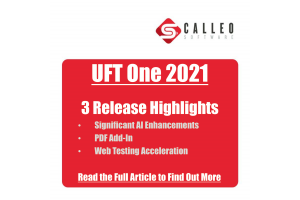Micro Focus has released UFT One 2021. The latest version of their class-leading test automation tool. We’ve selected our 3 release highlights.
If you’re not familiar with Micro Focus UFT One, it waspreviously called UFT Enterprise and is an evolution of the QuickTest Professional (QTP) and WinRunner automation tools.
With UFT you also get UFT Developer, which was previously known as UFT Pro and LeanFT.
UFT One is essentially 4 tools in 1 package:
- Web automation
- API automation
- GUI automation
- Mobile device automation
If you’re looking for a test automation tool, you need to look no further than UFT One. It supports more applications and technologies than any other tool.
Important Recent Advances
These days, UFT One includes sophisticated artificial intelligence (AI). It also integrates seamlessly with open-source tools. For example, you can execute Selenium scripts in UFT One.
UFT One is regularly updated with additional features and enhancements. UFT One 2021 is currently the latest version and was released on 13 September 2021.
UFT One 2021 – 3 Release Highlights
UFT One 2021 includes several new features. We’ve highlighted the top 3 release highlights for you below:
1. Significant AI Enhancements
UFT One 2021 adds additional AI-based testing functionality to an already powerful tool. Included in the latest release are:
- Remote AI Service – You can install the AI service on a powerful central machine. Less powerful script development computers (e.g. laptops) can tap into this AI service as required, and benefit from the increase in AI speed.
- AI model update – AI models are the frameworks used to build scripts, they identify and categorise on-screen objects, and control how UFT interacts with them. This new model is more accurate and improves test performance.
- Object identification verification – This automatically checks whether an object has changed, prior to performing an operation
Also included in the AI Changes are
- New methods
- Renewed interface for learning AI objects and building tests
- Text recognition in additional languages
- Additional control types supported
- Container objects
- Performance improvement
Visit the Micro Focus site for more information on the UFT One 2021 AI capabilities.
2. PDF Add-in (tech preview)
Testing PDF documents used to be impossible without additional software, namely Adobe Acrobat Pro. Micro Focus has addressed these issues in UFT One.
With UFT One 2021, you are now able to:
- Open PDF documents
- Display PDF documents
- Interact with PDF documents.
Visit the Micro Focus site for more information on the UFT One PDF Add-in
3. Web testing acceleration
Web testing with UFT One is now even faster than before.
Micro Focus UFT Oneuses a different mechanism when running web tests on Chrome, Chromium Edge, and Firefox. This accelerates test execution and gives you back valuable project time.
The speed increase is particularly noticeable when using VRI to identify objects and with screen captures enabled.
Visit the Micro Focus site for more information on the UFT One Web Testing Enhancements

















